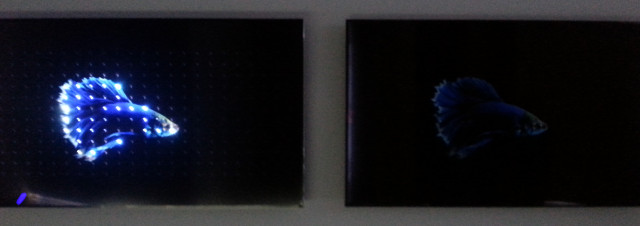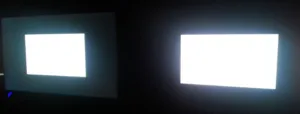At the New York kick off of Vizio’s new Reference series UHD TVs, there were a number of demo stations set up to showcase the image quality of the TVs. Some of these demos compared the Vizio set to Samsung’s latest 65” UHD TV that features High Dynamic Range (HDR) and a Wide Color Gamut (WCG).
One demo featured very dark content in a very dim area. This side-by-side was meant to show the great black levels of the Vizio set compared to the Samsung set when playing identical content. The Samsung TV is an edge-lit model which was compared to a direct backlight type Vizio TV.
As expected, the black levels were much better in the Vizio TV. On the Samsung set, the blacks were often tinged with blue and showed more banding going from blue to black. This was not apparent on the Vizio sets. Content was mostly stars, nebula and flowing gases, so not typical content, but it did prove the point.
A second side-by-side demo pitted the same Samsung and Vizio TVs against a Pioneer Kuro PDP TV. Here, the idea was to look at the color capabilities of the TVs. The first image was a black background with a white segment in the middle, occupying about 20 % of the area. This showed the same effect as the previous demo with the Samsung’s black area considerably brighter than the Vizio or PDP. Next, full red, green and blue fields were shown. The sets were in vivid mode so these were as full a saturation of each color as the sets could muster. This also changed the white points dramatically so they were over 11K on the Vizio and Samsung sets.
The Samsung TV was set to peak luminance and achieved about 425 nits in white whereas the Vizio set was adjusted to 50% of luminance to offer about 400 nits and match the Samsung. The Pioneer set was noticeably dimmer.
Samsung uses its own quantum dot technology they call nanocrystals*, whereas the Vizio set uses quantum dot materials from Nanosys, integrated into a film sold by 3M. This showed that the red and green was a bit more saturated in the Vizio set, but this impression of was amplified when the set was boosted to full luminance. The Kuro set offers a 709 gamut so showed different RGB colors that were also less saturated.
A third demo showed two side-by-side TVs (Samsung vs. Vizio again) to show off the features of the direct backlight. In both sets, the diffusers and prism films were removed. This allowed the LEDs to be quite visible in the Vizio set with bright element lighting up the images whereas the Samsung edge-lit set was quite dim.

Finally, there were two areas where content was being shown. One area featured a series of the 65” TVs playing HDR content, including a live Vudu stream at 15 Mbps. I watched a clip from the Lego movie and the Man of Steel. The Lego movie looked very nice with vibrant colors while Man of Steel showed a lot of noise in the darker regions, this turned out to be film grain as it was shot on celluloid. Otherwise, I did not see artifacts or drop outs even at this low bit rate. The TV has a Vudu app that will recognize the dual stream Dolby Vision HDR content and render it appropriately. This dual stream approach requires about 20% more bandwidth. Pretty impressive.
The second content demo area was a purpose built home theater that featured the 120” version and the sound bar and woofer from the 65” model. The clips were impressive. – CC
* My understanding is that the Samsung QD films use the materials developed by Samsung Advanced Institute of Technology (SAIT), in a film developed in Korea. (BR)

